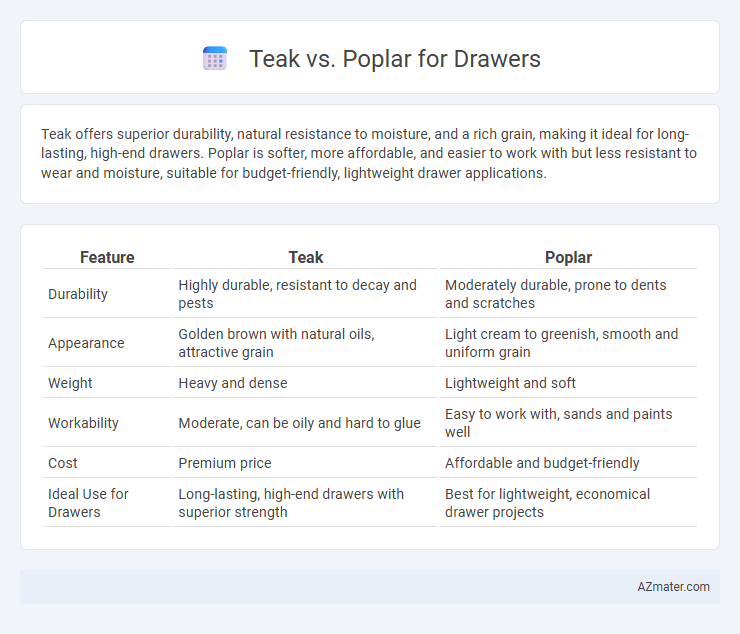Teak offers superior durability, natural resistance to moisture, and a rich grain, making it ideal for long-lasting, high-end drawers. Poplar is softer, more affordable, and easier to work with but less resistant to wear and moisture, suitable for budget-friendly, lightweight drawer applications.
Table of Comparison
| Feature | Teak | Poplar |
|---|---|---|
| Durability | Highly durable, resistant to decay and pests | Moderately durable, prone to dents and scratches |
| Appearance | Golden brown with natural oils, attractive grain | Light cream to greenish, smooth and uniform grain |
| Weight | Heavy and dense | Lightweight and soft |
| Workability | Moderate, can be oily and hard to glue | Easy to work with, sands and paints well |
| Cost | Premium price | Affordable and budget-friendly |
| Ideal Use for Drawers | Long-lasting, high-end drawers with superior strength | Best for lightweight, economical drawer projects |
Introduction: Teak vs Poplar for Drawer Construction
Teak and poplar differ significantly in durability and appearance, impacting drawer construction choices. Teak offers exceptional strength, natural resistance to moisture, and rich grain patterns ideal for high-quality, long-lasting drawers. Poplar is softer and more affordable, featuring a smooth, light-colored surface well-suited for painted or less demanding drawer projects.
Wood Characteristics: Teak and Poplar Overview
Teak is renowned for its exceptional durability, natural oils that resist moisture and pests, and rich golden-brown hue, making it ideal for high-quality drawer construction. Poplar, a softer hardwood with a pale yellow-green to light brown color, offers ease of machining and cost-effectiveness but lacks the moisture resistance and hardness of teak. Choosing teak ensures longevity and premium aesthetics, while poplar serves well for budget-friendly, painted, or less demanding drawer applications.
Durability Comparison: Teak vs Poplar
Teak is renowned for its exceptional durability, boasting high resistance to moisture, pests, and warping, making it ideal for long-lasting drawer construction. Poplar, while moderately durable, is softer and more prone to dents and scratches, which limits its longevity in high-use furniture like drawers. Choosing teak over poplar ensures superior strength and durability, especially in environments exposed to humidity or frequent handling.
Aesthetic Appeal: Grain and Color Differences
Teak drawers showcase a rich, golden-brown hue with a distinctive, straight grain pattern that deepens over time, offering a luxurious and warm aesthetic. Poplar features a lighter cream to greenish-brown color with a more subtle, uniform grain that provides a smooth, understated appearance. The choice between teak's dramatic, natural elegance and poplar's more neutral, adaptable look depends on the desired style and visual impact in furniture design.
Workability and Ease of Assembly
Teak offers excellent workability due to its natural oils, which make it resistant to warping and easy to sand, though it can dull tools faster. Poplar is softer and much easier to machine, shape, and assemble, making it ideal for detailed drawer construction and quick assembly. While teak provides durability and moisture resistance, poplar excels in ease of assembly and smooth finishing, especially for DIY or intricate drawer projects.
Cost Analysis: Teak vs Poplar
Teak wood is significantly more expensive than poplar due to its durability, natural oils, and resistance to moisture and pests, making it a premium choice for drawers in high-end furniture. Poplar offers a cost-effective alternative with its lower price point and decent workability, although it lacks the longevity and rich finish of teak. Budget-conscious projects often favor poplar for drawer construction, while teak is preferred for long-term investment pieces requiring superior strength and aesthetic appeal.
Environmental Impact and Sustainability
Teak wood, known for its durability and resistance to pests, is often harvested from slow-growing tropical forests, raising concerns about deforestation and habitat loss if not sourced sustainably. Poplar, a fast-growing hardwood primarily cultivated in managed plantations, offers a more renewable option with lower environmental impact due to quicker replenishment cycles and efficient land use. Choosing FSC-certified teak or poplar ensures responsible forestry practices, minimizing ecological footprints and supporting sustainable drawer manufacturing.
Maintenance Requirements for Drawers
Teak drawers require minimal maintenance due to their natural oils, which enhance resistance to moisture and pests, making them highly durable in humid environments. Poplar drawers, being a softer hardwood, need regular sealing or painting to prevent damage from moisture and wear, increasing upkeep demands. For long-lasting drawer functionality with reduced maintenance time, teak is a more practical choice compared to poplar.
Best Applications for Each Wood
Teak is ideal for drawer construction in high-humidity environments due to its natural oil content and exceptional durability, making it perfect for kitchen or bathroom cabinetry. Poplar, being softer and more affordable, suits interior drawers that require easy painting and smooth finishes, especially in furniture that emphasizes cost-effectiveness and quick production. Both woods serve distinct purposes, with teak favored for moisture resistance and longevity, while poplar excels in versatility and budget-friendly projects.
Conclusion: Choosing Between Teak and Poplar for Drawers
Teak offers exceptional durability, natural resistance to moisture, and a rich, warm appearance ideal for high-end drawer construction. Poplar provides an affordable, lightweight option with a smooth grain, suitable for painted or stained drawers in budget-conscious projects. Selecting between teak and poplar depends on prioritizing longevity and aesthetics versus cost-effectiveness and ease of customization.

Infographic: Teak vs Poplar for Drawer
 azmater.com
azmater.com